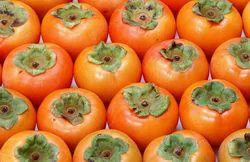 Persimmon (Diospyros kaki) is widely grown in the East Asia, it is classified into astringent and non-astringent varieties depending on the astringency degree of fruits at harvest.
Persimmon (Diospyros kaki) is widely grown in the East Asia, it is classified into astringent and non-astringent varieties depending on the astringency degree of fruits at harvest.The non-astringent fruits are directly consumed as fresh fruit, while the astringent fruits are subjected to a deastringency treatment before consumption.
Recently, it has been discovered that fresh astringency-removed fruits have better quality than naturally non-astringent persimmons but they have a shorter shelf-life.
The "Cheongdobansi" is an astringent variety cultivated in the Korean Region Cheongdo, it is a seedless variety and thanks to its excellent quality it is processed into several food products.
A group of Korean scientists have investigated the effect of deastringency treatments on the quality of fresh-cut persimmon. The deastringency treatments were applied on the intact fruits before minimal processing, which consisted of washing with sodium hypochlorite, peeling and cutting the fruits into 4 wedges, packaging in plastic trays and storing fresh-cut fruits at 6°C for 10 days.
To remove astringency from the intact fruit, the scientists tested three methods:
- 2 days at 20°C in 80% CO2 atmosphere;
- 2 days at 35°C in a water bath;
- 6 days at 20°C in 35% ethanol atmosphere of 35%;
- Control, untreated fruit.
Moreover, the scientists found that compared to control the deastringency treatments could decrease the content of soluble tannins, soluble solids, titratable acidity and antioxidant activity of intact fruit. However, among the tested deastringency treatments the water bath had the least impact on the antioxidant activity.
The scientists conclude that the present work will continue with further studies on the water bath method as deastringency treatment of whole fruits from astringent varieties in controlling the quality of fresh-cut persimmon.
Source: Chung H-S., Kim H-S., Lee Y-G., Seong J-H., "Effect of deastringency treatment of intact persimmon fruits on the quality of fresh-cut persimmons", 2015, Food Chemistry, Vol.166, page. 192-197.
http://www.ncbi.nlm.nih.gov/pubmed/25053045
